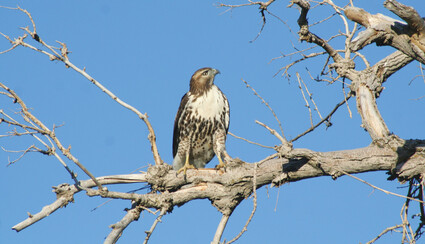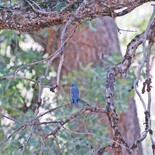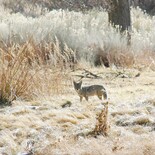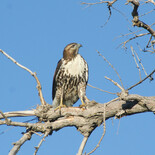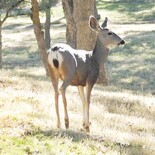A day in an oak woodland
Land of Four Seasons
November 25, 2023
One of the most interesting of our local habitats to explore and to experience the outdoors is also one of the Tehachapi Mountains' most widespread and interesting: the oak woodland.
This plant community is abundant in Central and Southern California, and found throughout the Tehachapis. Locally, it consists primarily of Valley Oak (Quercus lobata) and Blue Oak (Quercus douglasii) trees interspersed with Gray Pines, California Buckeyes, Mountain Mahogany, Buckbrush, Great Basin Sagebrush and a variety of perennials and annuals.
Oak woodlands are one of the richest habitat types in California in terms of wildlife. At first glance, other plant communities may look like they would host more animals – in our area, for example, the coniferous forests of Jeffrey Pine and White Fir found at higher elevations in the mountains south of town look greener and more lush.
However, the shortage of sunlight that reaches the floor of these forests limits the amount of wildlife that can thrive there. Most food chains in our area are fairly simple grass-rodent-predator combinations, and there simply isn't as much grass and understory plants in shaded, acidic forest soil as there is in the richer soil and sunnier conditions under the oaks.
Some of the first animals you may see will be California Mule Deer, picking their way carefully across the slopes as they follow the shadows of the oak trees. By remaining mostly in the shadows and filtered sunlight beneath oak trees, deer greatly reduce their visibility to predators. Oaks provide deer with shelter, shade and food in the form of acorns and new tender leaves which the deer love to browse.
Bright flashes of blue may catch your eye as small groups of Western bluebirds fly from oak to oak. These beautiful birds are year-round residents of the oak woodlands, and in spring they pair up for nesting. They occasionally flit out to catch insects on the wing and then return to their perches on oak branches and twigs. I'm sure that each spring they welcome the return of warmer weather and accompanying insects – insectivores like bluebirds must switch to eating mostly mistletoe berries and other fruits and berries in winter when cold temperatures make insects unavailable.
When I was hiking through an oak woodland south of Highline Road, I spotted a young coyote chewing up a piece of carrion. It looked to be the remains of a ground squirrel, which the coyote had apparently discovered near the base of an oak. The coyote quickly trotted off after seeing me.
The coyote wasn't far from the group of deer, but they showed no alarm and the lone coyote showed no interest. Coyotes aren't major predators of deer – they will certainly take a new fawn or a dying adult if the opportunity presents itself, but most deer predation comes from mountain lions, not coyotes.
Like most cats, mountain lions are true carnivores, eating little other than meat. Coyotes, on the other hand, are consummate omnivores. Their philosophy seems to be "If it's edible, eat it. If you're not sure, eat it anyway," and a coyote's digestive system seems to be able to handle nearly anything. Coyote scat can contain the most random assortment of seeds, bones, sticks, insect remains, plastic bags, fur, etc.
A long, descending whistle-like cry made me look up and I saw a pair of Red-tailed Hawks, one of them circling above a large valley oak and the other perched in the tree. They may have raised chicks together earlier this year.
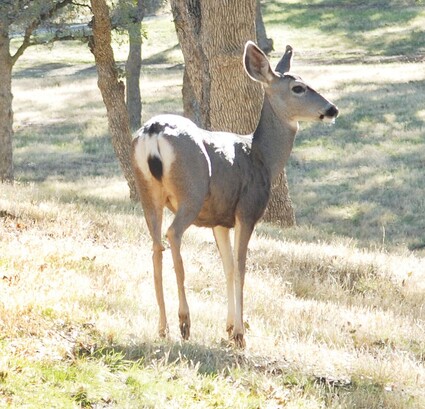
Jon Hammond.
An adult California Mule Deer looked up to see it was being left by the rest of the small herd, and then it bounded away to catch up to the others.
Hopefully this will be another wet winter, and in a few months there will start to be wildflowers again, and the soft green grass that sprouted from Hurricane Hilary in August will be joined by forbs and more grasses.
In the meantime, it is a great season to enjoy oak woodlands, which are one of our most productive and interesting plant communities. Leaves have changed color, acorns are still dropping, and various wildlife are collecting the bounty of the oaks.
Keep enjoying the beauty of life in the Tehachapi Mountains.
Jon Hammond is a fourth generation Kern County resident who has photographed and written about the Tehachapi Mountains for 38 years. He lives on a farm his family started in 1921, and is a speaker of Nuwä, the Tehachapi Indian language. He can be reached at tehachapimtnlover@gmail.com.


